Automobiles
What do these photos tell you about how their automobiles looked like?
An Electric Automobile (1925)
This auto was powered by electric batteries. The photo was taken in Denver about 1925.
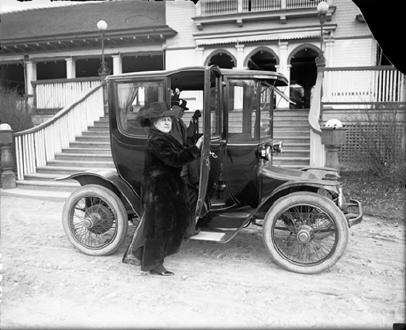
Photo: Denver Public Library, Western History Collection
More About This Topic
Several early models of automobiles were electric-powered. They lost out to gasoline-powered models because they could not go very far without having their batteries recharged. However autos were powered, they began to change people's lives.
Their Own Words
“The dances and all quit about, I suppose, in about 1920-21. Not too long after automobiles. Whenever cars got prevalent, why the community broke apart, after cars got too plentiful. [People] could go other places and do other things. The people would bring seats out of their car and make beds back in the corner for the kids to sleep on, and the kids went to sleep. When they got ready to go home they’d gather [the children] up and go home. You didn’t have baby sitters then, you sat your own kids.”
Source: Gertrude Tower quoted in Maria M. Rogers, ed., In Other Words: Oral Histories of the Colorado Frontier (Golden, CO: Fulcrum Publishing, 1996): 105.
A Lot Full Of Model T's
This lot is filled with new Model T Ford cars and trucks.
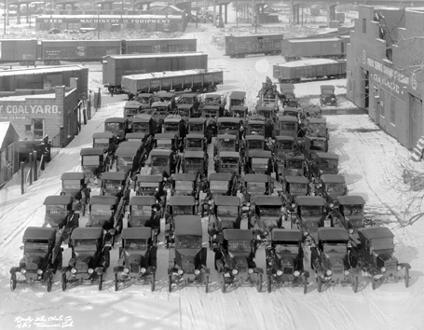
Photo: Denver Public Library, Western History Collection
More About This Topic
The most popular auto by 1920 was the Ford Model T. It was reliable and inexpensive. By 1926, one could buy a new Model T for as little as $300.
Their Own Words
“I learned to drive when I was twelve years old. I just learned to drive by myself, nobody to teach me. You didn’t have to have a driver’s license. It was a great shift, an old Model T. And one day I was allowed to take the car, I guess I was about fifteen at the time. . . . We went out on Arapahoe [Road], and I bumped into a bunch of cows. I couldn’t stop fast enough. It didn’t damage the car or anything, but I was scared to death to tell my folks about it. And I didn’t get the car by myself after that.”
Source: Della Friedman quoted in Maria M. Rogers ed., In Other Words: Oral Histories of the Colorado Frontier (Golden, CO: Fulcrum Publishing, 1996): 72.
A 1928 Model A Ford
The auto in this photo is a 1928 Model A Ford.
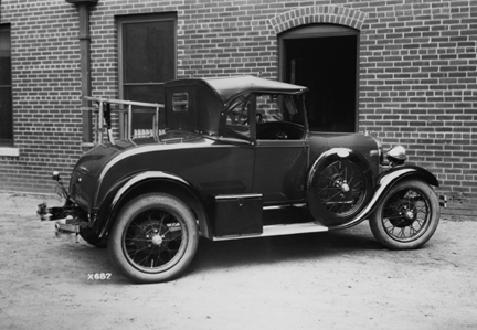
Photo: Colorado Historical Society
More About This Topic
In 1922, the Ford Motor Company began making its Model A car and stopped making the Model T. The auto in this photo was the roadster model, which was a two-seat car with a canvas top. It had a third seat or “rumble seat” that opened up in back next to the trunk.
Their Own Words
“I remember one time in coming across the plains in a Model A roadster. I had no side curtains. I had a roof, a canvas-top roof, but no side curtains. . . . Just in case there were high winds and so forth, I made myself a pair of side curtains out of linoleum, yes, just to shield the wind. . . . I had to take whatever came. Rain, if it rained from the side, and the rain slanted in, well, I just sat there and drove the car and got soaked. . . . Traveling in a Model A roadster was quite a thrill.”
Source: Raymond Friese quoted in Maria M. Rogers, ed., In Other Words: Oral Histories of the Colorado Frontier (Golden, CO: Fulcrum Publishing, 1996): 73.
A Gray Light Car
The Gray Light Car advertised in this photo was manufactured in Longmont, Colorado.
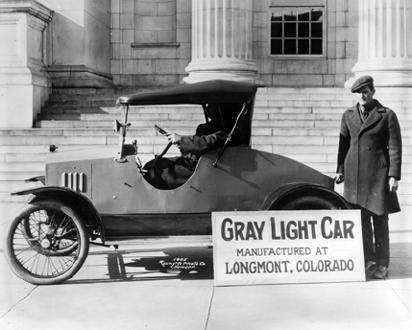
Photo: Denver Public Library, Western History Collection
More About This Topic
During the early years of the auto industry, manufacturers in hundreds of cities introduced models of cars. Most of these small auto companies failed, as did the Gray Company of Longmont.
Their Own Words
“The automobile, Dr. Bartlett stated, is as reliable for travel as any locomotive. Today, he said, there are 200 concerns [companies nation-wide] engaged in the manufacture of automobiles, the combined capital of the industry being $25,000,000. In this city [Denver] alone, he estimated, there were nearly $1,000,000 worth of [these] machines. ‘I will venture to say that in ten years the automobile will displace seventy-five percent of the horses now in use.’”
Source: Colorado Transcript (Golden, Colorado), August 3, 1905.
A Line Of Yellow Cabs (1930's)
These autos are taxicabs operated by the Yellow Cab Company. The photo was taken in Denver during the 1930s.
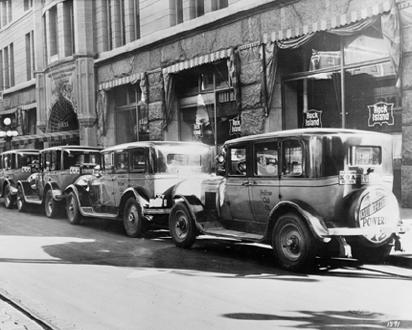
Photo: Denver Public Library, Western History Collection
More About This Topic
During the 1920s, horse-drawn carriages-for-rent were replaced by gasoline-powered taxicabs.
Their Own Words
“But the vogue of the bicycle was brief. The phenomenally rapid increase of automobiles, satisfying as they did the urge for greater speed, gradually relegated [horse]-propelled and man-propelled vehicles to the realm of the obsolete until at the end of the first quarter of the present century [i.e., about 1925], save for the wheels of messenger boys and newspaper carriers, the ubiquitous ‘auto’ possessed the streets and highways of Colorado and horses and bicycles were as rare as were automobiles at the beginning of the century. Now we have the motor bus and the airplane. What next?”
Source: Andrew Gillette, “The Bicycle Era in Colorado,” Colorado Magazine, 10 (November 1933): 14.
Stuck In A Ditch
The men in this photo are digging out a car stuck in mud. The driver had tried to cross a shallow creek.
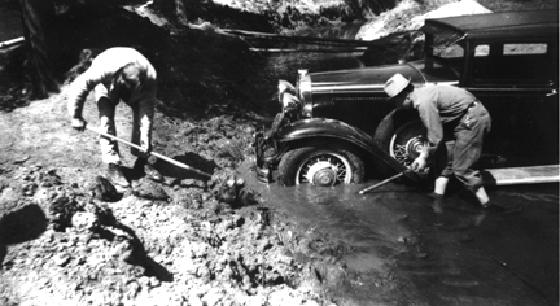
Photo: Denver Public Library, Western History Collection
More About This Topic
Roads that were quite adequate for horse-drawn vehicles often were not good roads for automobiles. The driver of the auto in this photo could easily have crossed this creek in a horse-drawn buggy. The growing use of autos led states and counties to build more bridges and better roads.
Their Own Words
“We used to have a wagon. . . . We’d go up Boulder Canyon at that time gettin’ our dynamite, right on the main road. . . . Then we moved to an International truck, hard rubber tires, chain drive. It was comin’ down [the canyon] one day and the boys got ta goin’ too fast . . . and went off into Boulder Crick. The driver was just flyin’, boxes broke open. Not a one went off. Powder won’t go off; it needs ignitin.’ But we had a lot of incidences. It was an interesting life.”
Source: John Valentine quoted in Maria M. Rogers, ed., In Other Words: Oral Histories of the Colorado Frontier (Golden, CO: Fulcrum Publishing, 1996): 47.

